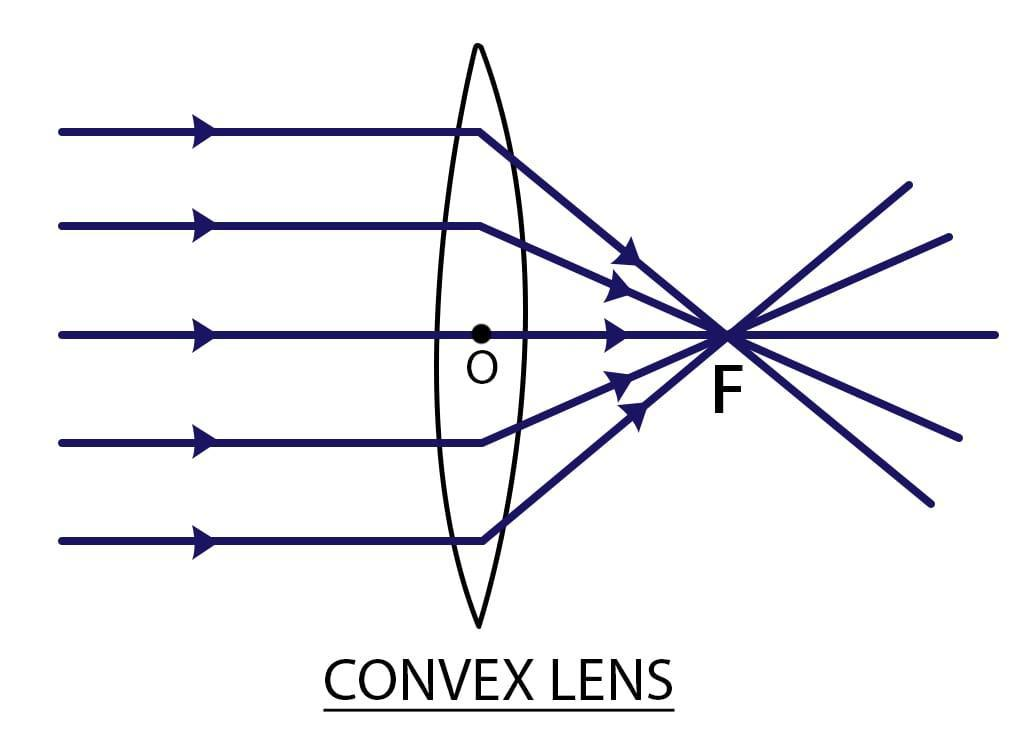
An object 5cm high is held 25 cm away from a converging lens of focal length 10cm. What is the image distance?
Answer
568.8k+ views
Hint: The solution of this problem is easy as it is purely based on the lens formula which is $\dfrac{1}{v} - \dfrac{1}{u} = \dfrac{1}{f}$ where u is the position of object, v is the position of image and f is the focal length. We will substitute the value of u (object position) and the focal length as 5 and 10 cm respectively and find out the image distance.
Complete step by step answer:
Step 1:
Before coming to the question let us see what a convex lens is
A convex lens is also called a converging lens because it makes parallel light rays passing through it bend inward and meet (converge) at a spot just beyond the lens known as the focal point. Photo: A convex lens makes parallel light rays converge (come together) at the focal point or focus.

Step 2:
From the equation of the lens we can write $\dfrac{1}{v} - \dfrac{1}{u} = \dfrac{1}{f}$ … (1) where u is the position of object, v is the position of image and f is the focal length.
Given:
Height of the object =5cm
Position of the object, u=−25cm
Focal length of the lens f=10cm
We need to find the position of the image v
From the equation of the lens we can write $\dfrac{1}{v} - \dfrac{1}{u} = \dfrac{1}{f}$, where u is the position of object, v is the position of image and f is the focal length we will find out the position of the image
Putting into the lens formula, $\dfrac{1}{v} = \dfrac{1}{{10}} - \dfrac{1}{{25}}$
This gives us the position of the image as $\dfrac{{50}}{3}$ or 16.66 cm
The ray diagram of our solution is below:

Additional information:
Some convex lens uses are given below:
-Used in magnifying glasses. One of the most direct and simplest uses of a convex lens is in a magnifying glass.
-Convex lenses are used in eyeglasses.
-Uses of convex lenses in cameras.
-Used in microscopes.
Note:With the lens formula we can get any of the quantity either focal length, or position of object or image and also we can find out the magnification and nature of the image as magnification is equal to the divide of height of the image to the height of the object and negative sign means the image will be inverted.
Complete step by step answer:
Step 1:
Before coming to the question let us see what a convex lens is
A convex lens is also called a converging lens because it makes parallel light rays passing through it bend inward and meet (converge) at a spot just beyond the lens known as the focal point. Photo: A convex lens makes parallel light rays converge (come together) at the focal point or focus.

Step 2:
From the equation of the lens we can write $\dfrac{1}{v} - \dfrac{1}{u} = \dfrac{1}{f}$ … (1) where u is the position of object, v is the position of image and f is the focal length.
Given:
Height of the object =5cm
Position of the object, u=−25cm
Focal length of the lens f=10cm
We need to find the position of the image v
From the equation of the lens we can write $\dfrac{1}{v} - \dfrac{1}{u} = \dfrac{1}{f}$, where u is the position of object, v is the position of image and f is the focal length we will find out the position of the image
Putting into the lens formula, $\dfrac{1}{v} = \dfrac{1}{{10}} - \dfrac{1}{{25}}$
This gives us the position of the image as $\dfrac{{50}}{3}$ or 16.66 cm
The ray diagram of our solution is below:

Additional information:
Some convex lens uses are given below:
-Used in magnifying glasses. One of the most direct and simplest uses of a convex lens is in a magnifying glass.
-Convex lenses are used in eyeglasses.
-Uses of convex lenses in cameras.
-Used in microscopes.
Note:With the lens formula we can get any of the quantity either focal length, or position of object or image and also we can find out the magnification and nature of the image as magnification is equal to the divide of height of the image to the height of the object and negative sign means the image will be inverted.
Recently Updated Pages
Master Class 12 English: Engaging Questions & Answers for Success

Master Class 12 Economics: Engaging Questions & Answers for Success

Master Class 12 Social Science: Engaging Questions & Answers for Success

Master Class 12 Maths: Engaging Questions & Answers for Success

Master Class 12 Chemistry: Engaging Questions & Answers for Success

Master Class 12 Business Studies: Engaging Questions & Answers for Success

Trending doubts
What are the major means of transport Explain each class 12 social science CBSE

Which are the Top 10 Largest Countries of the World?

Draw a labelled sketch of the human eye class 12 physics CBSE

Explain sex determination in humans with line diag class 12 biology CBSE

The pH of the pancreatic juice is A 64 B 86 C 120 D class 12 biology CBSE

Explain sex determination in humans with the help of class 12 biology CBSE




